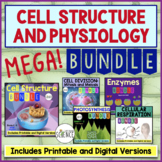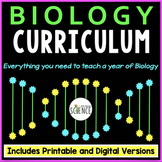Cell Organelles Structure and Function Powerpoint and Notes
- Zip
- Google Apps™

What educators are saying
Also included in
- This Cell Structure Bundle has you covered from start to finish. It covers the history of cell studies, the cell theory, characteristics of living organisms, prokaryotic and eukaryotic cells, the cell organelles found in both animals and plants, and cellular transport (osmosis, diffusion, active andPrice $49.99Original Price $73.71Save $23.72
- Five of my best-selling complete teaching bundles are included in this one Super-Mega-Bundle! This bundle includes all of the PowerPoints, notes, labs, task cards, homework assignments, review games, quizzes, activities, and unit tests that you need to teach complete and comprehensive units on cellPrice $189.99Original Price $268.09Save $78.10
- This NO PREP, PRINTABLE, EDITABLE, AND DIGITAL Biology Curriculum contains everything you need for an entire year of Biology! For less than $3 a day, you can save your time, energy, and sanity. Each of the 20 Complete Units includes a teaching PowerPoint presentation, notes, labs, homework assignmenPrice $525.00Original Price $988.18Save $463.18
Description
These 111 slides will captivate your students with stunning photos and diagrams to provide an in-depth study of cell structures and their functions. Choose to use the traditional printable version, or the paperless, digital Google Apps version. The PowerPoint covers all the topics you would expect to find in a traditional high school biology textbook, including the history of cell studies, characteristics of life, the organelles of plant and animal cells, transport across membranes, and so much more. Please see the detailed list of topics below.
This resource is perfect for traditional classroom settings, distance learning, flipped classrooms, or for students in 1:1 classrooms.
What is included in this product?
- A 111-Slide Editable PowerPoint Presentation (Includes traditional PowerPoint, PDF, and Google slides)
- Editable and printable 16-page set of lecture notes for the teacher
- Editable and printable 21-page guided notes outline for the student
- Paperless Digital Versions (not editable) for use in Google Drive, Google Classroom, and /or Microsoft OneDrive
The Power Point is designed to hold the attention of your students. The 111 slides are bright and colorful and contain loads and loads of visually appealing pictures and images. Animations and transitions are included to allow you to control the pace of the lesson.
Your students are going to love using the outline as you teach. It allows the student more freedom to listen, think, and ask questions during note-taking. The notes are also perfect for students with disabilities or IEP's.
The topics covered include the following:
- The History of Cell Studies: Robert Hooke, Anton van Leeuwenhoek, Schleiden, Schwann, and Virchow.
- The Cell Theory.
- Characteristics of living organisms and processes carried out by all cells.
- Diversity in cell shape and size, surface area-to-volume ratio in cells.
- Characteristics common to all cells: Cell membrane, cytoplasm, control center.
- Differences between prokaryotic and eukaryotic cells.
- The Animal Cell: Students will label a drawing of a typical animal cell.
- Detailed information about each of the following animal cell organelles: Cell membrane, nucleus (nuclear membrane, chromatin, nucleolus, nuclear pores, nucleoplasm), ribosomes, rough and smooth endoplasmic reticulum, Golgi apparatus, vesicles, lysosomes, peroxisomes, vacuoles, mitochondria, cytoskeleton, and centrioles.
- The synthesis and transport of proteins through the cell.
- The Plant Cell: Students will label a drawing of a typical plant cell.
- Differences between plant and animal cells.
- Detailed information about each of the following plant cell structures: Cell wall, chloroplasts, chromoplasts, leucoplasts (amyloplasts), and central vacuole.
- The diversity of cellular life: Unicellular organisms, colonial organisms, multicellular organisms, the advantages and disadvantages of cell specialization.
- Levels of cellular organization: Cells, tissues, organs, organ systems.
- The Cell Membrane: Students will label a drawing of the cell membrane. Functions of each part of the membrane are covered: Phospholipids, proteins, transport proteins, cholesterol, and carbohydrates.
- The Fluid-Mosaic Model of the cell membrane.
- Homeostasis and Cell Transport: Definition of homeostasis, how homeostasis is accomplished, permeability of the membrane, the concentration gradient.
- Passive Transport: Definition, diffusion, osmosis, equilibrium, isotonic solutions, hypertonic solutions, and hypotonic solutions.
- Detailed discussion of how animal cells and plant cells respond to isotonic, hypertonic, and hypotonic solutions: Plasmolysis and cytolysis.
- Practice Problems: Given the concentrations of various solutions inside and outside a dialysis bag, students will predict the movement of water and other substances into and out of the “cell.”
- Facilitated diffusion: Definition, carrier proteins, protein channels in the membrane.
- Active Transport: Definition, types of molecules that require active transport to move across the membrane, endocytosis, phagocytosis, pinocytosis, and exocytosis.
This PowerPoint and Notes set is so complete and comprehensive it can be used in place of a textbook. If you are already using a textbook you love, the PowerPoint and notes are editable and are easily incorporated into your existing lessons and units.
Related products include:
Cell Structure and Function Complete Teaching Bundle
Cell Organelles Color By Number
Color By Number: Characteristics of Life and Introduction to Cells
Cell Organelles Acrostic Puzzle
Cell Organelles Mix -n- Match Review Game
Lab Variation in Cell Structures and Cell Organelles
Cell Structure (Organelles) Hidden Picture Games - Set of 4 Games
Worksheet: The Importance of Surface Area to Volume Ratio in Cells
Cells (Plant and Animal) Quiz / Homework / Review
Lab: Osmosis and Diffusion in Living Cells
BOOM Cards for Cell Organelles High School Edition
BOOM Cards for Cell Organelles Middle School Edition
Lab Activity: Osmosis and Diffusion
Lab: Qualitative and Quantitative Plasmolysis
Lab: The Effect of Concentration on the RAte of Diffusion
Homeostasis / Cellular Transport Color By Number Activity
Cell Organelles Matching Worksheet
Lab: Diversity of Cell Structures
Quiz or Study Guide: Introduction to Cells
Quiz or Study Guide: The Animal Cell
Quiz or Study Guide: The Plant Cell
Quiz or Study Guide: Transport Across Membranes
Cell Organelles Crossword Puzzle
Transport Across the Cell Membrane Worksheet
Cellular Transport Across Membranes Crossword Puzzle
Cellular Transport Jeopardy Review Game
Test: Cell Structure and Function and Membrane Transport
Cell Structure and Physiology Interactive Notebook Pages, Warm Ups, or Bell Ringers
For updates about sales and new products, please follow my store:








